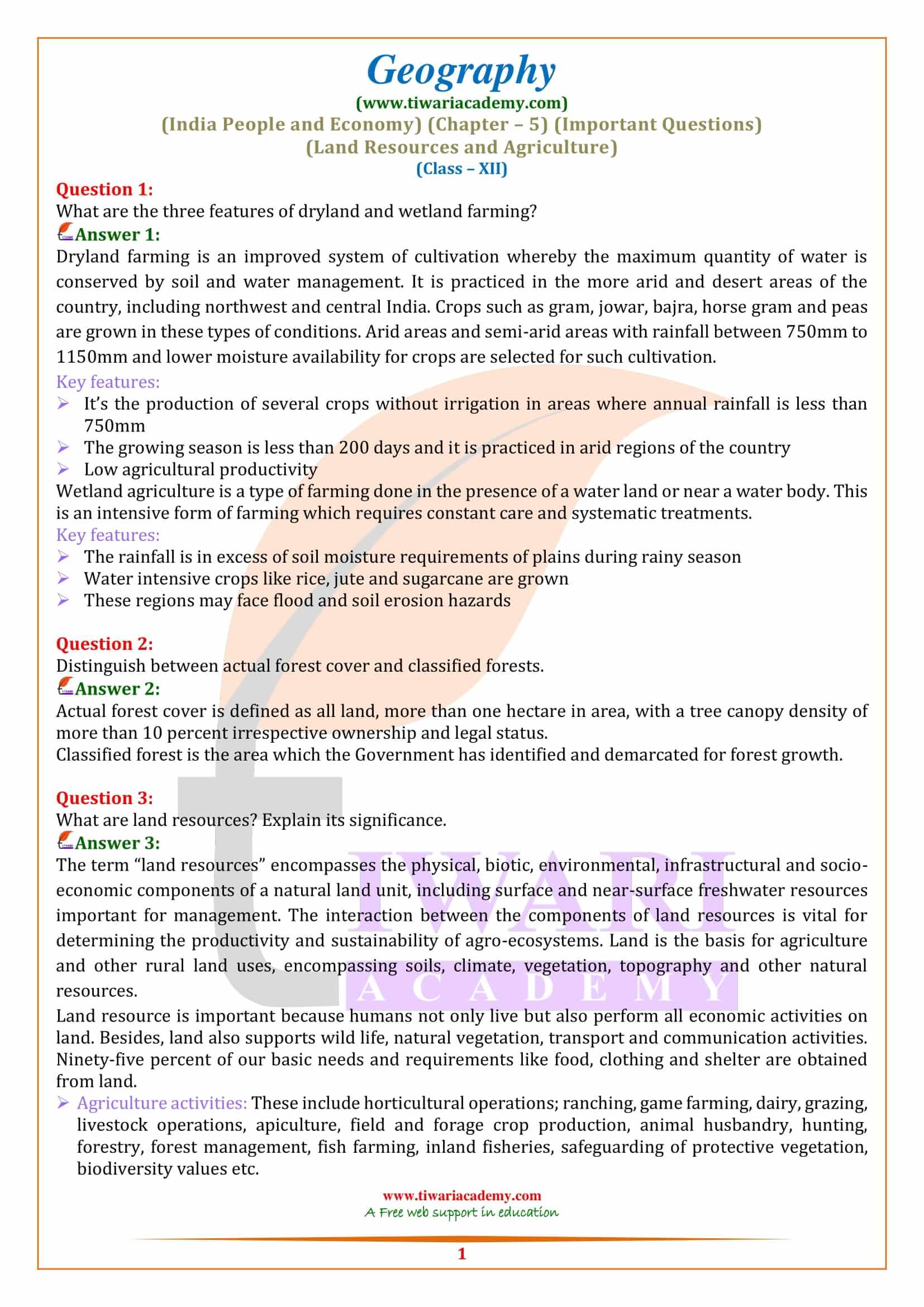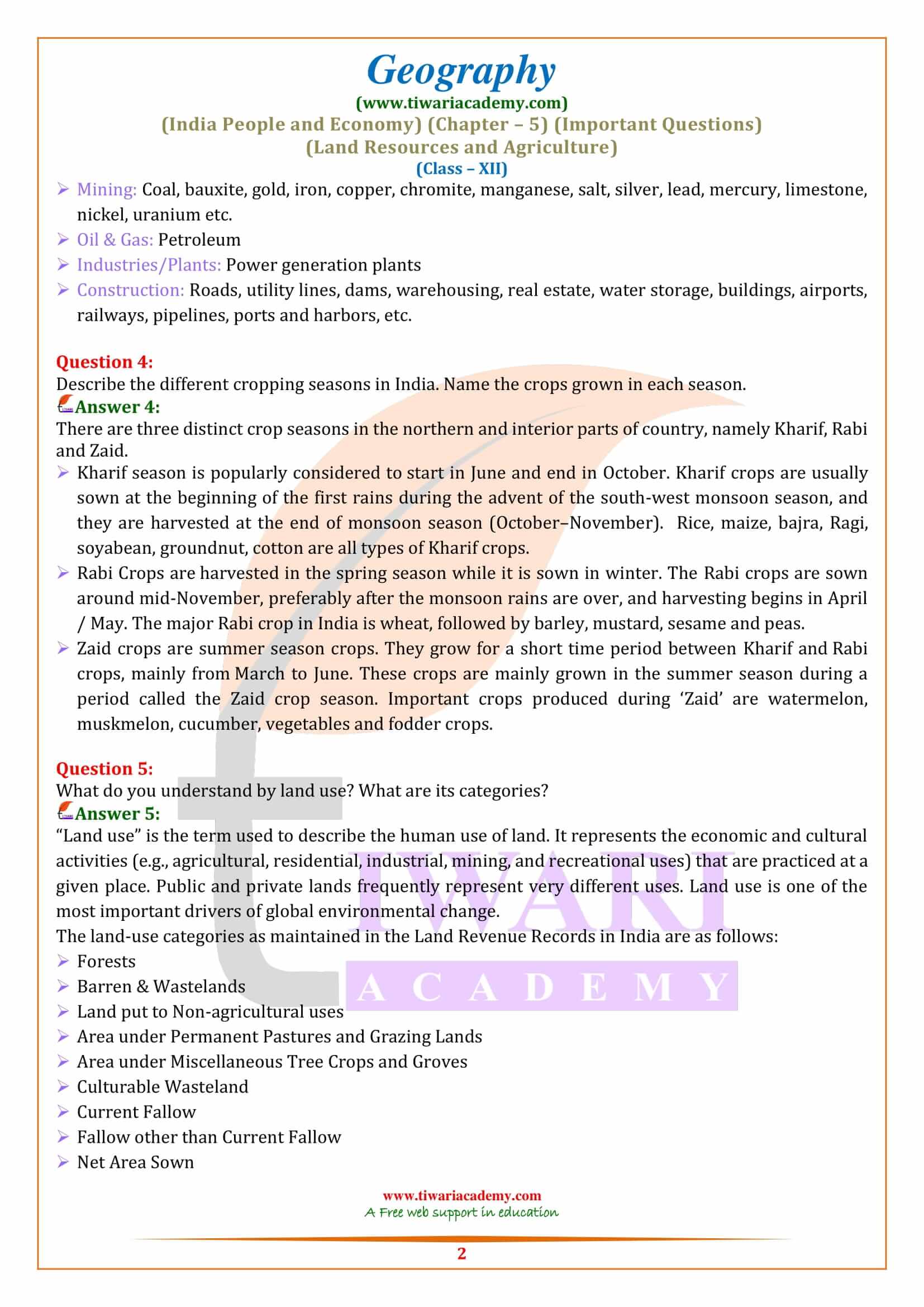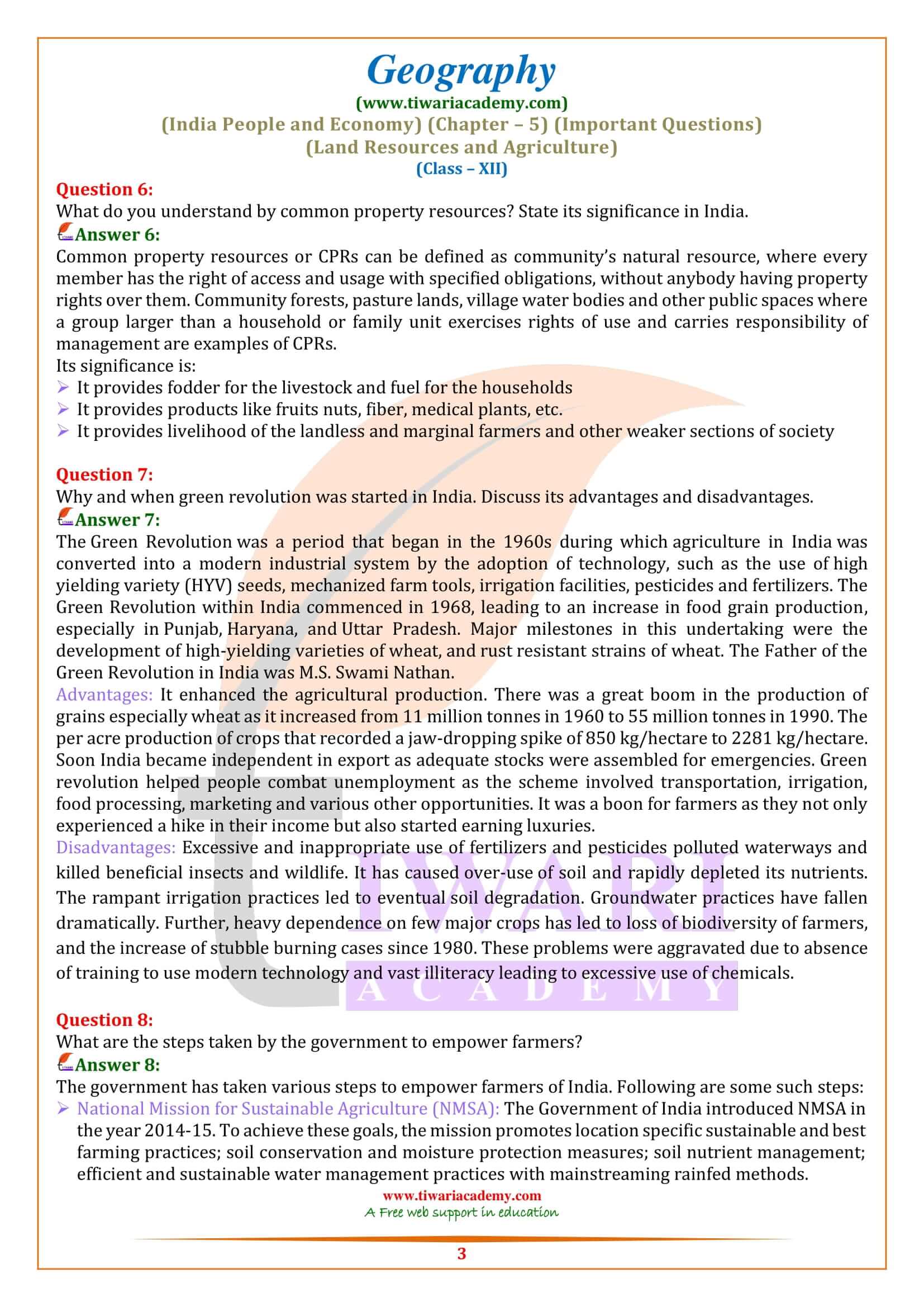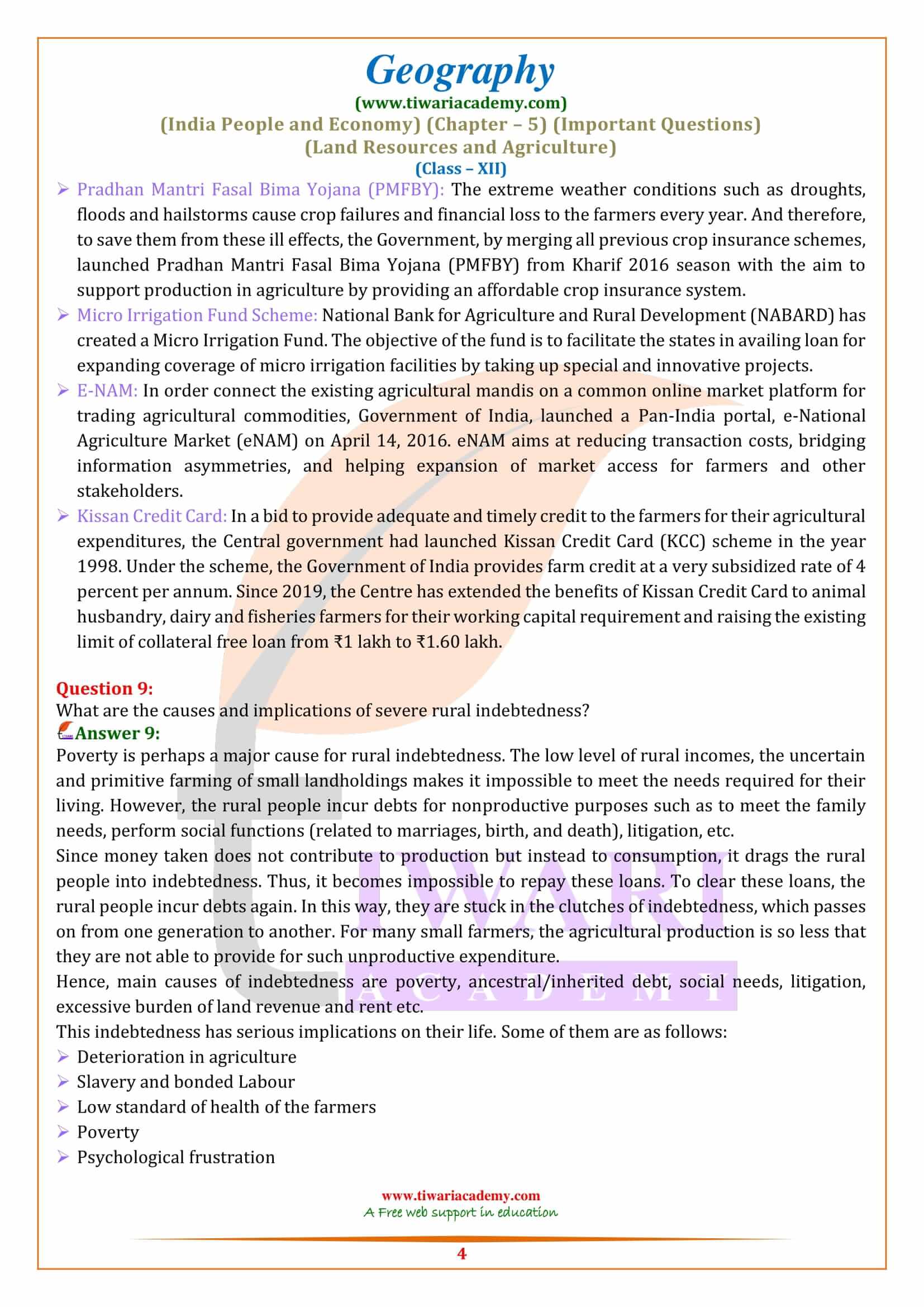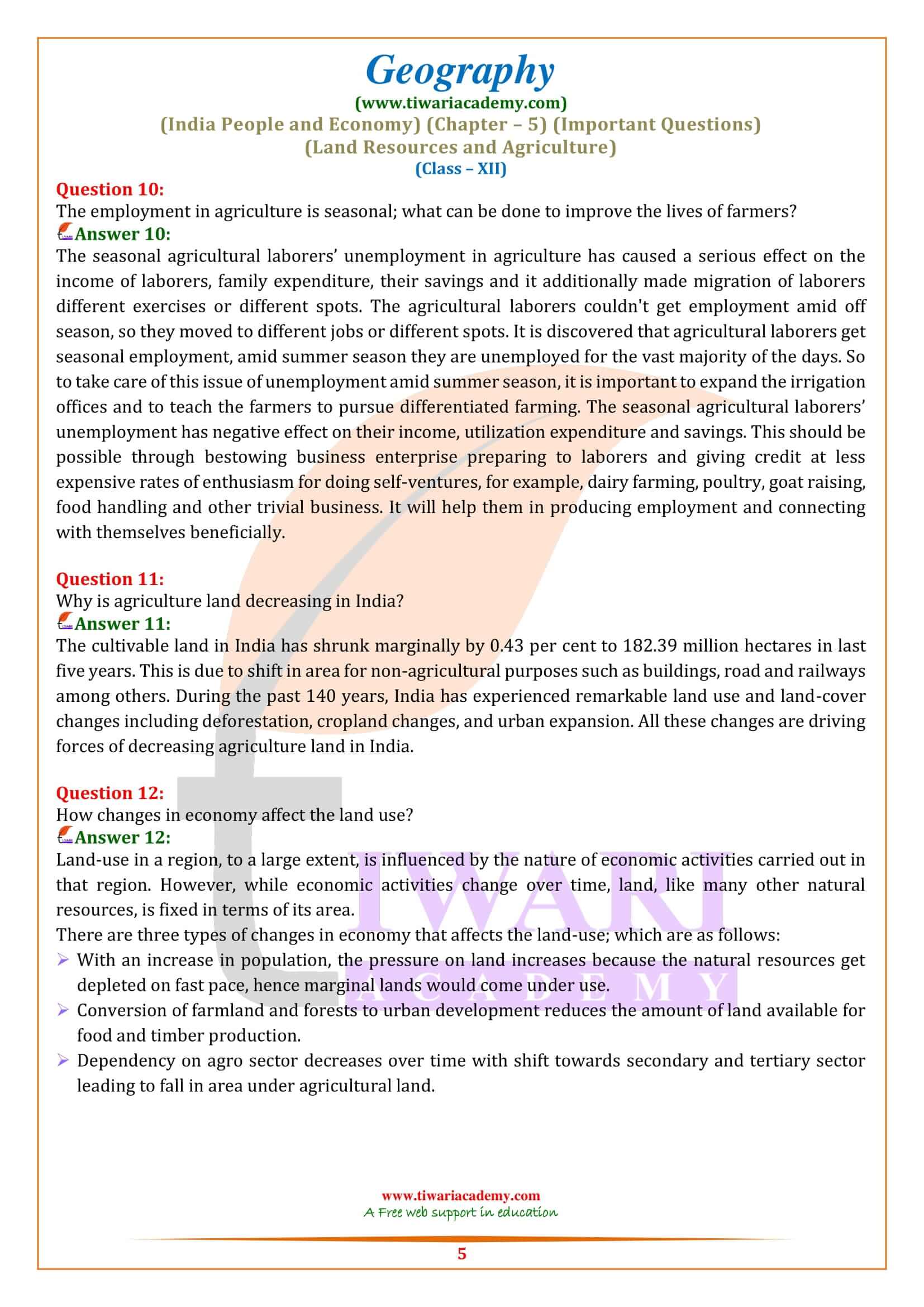Class 12 Geography Part 2 Chapter 5 Important Questions of Land Resources and Agriculture updated for new academic session 2024-25. Student can get here class 12 Geography chapter 5 extra question answers of second part India People and Economy with explanation.
Class 12 Geography Chapter 5 Important Questions
Class 12 Geography Chapter 5 Important Extra Question Answers
What are the three features of dryland and wetland farming?
Dryland farming is an improved system of cultivation whereby the maximum quantity of water is conserved by soil and water management. It is practiced in the more arid and desert areas of the country, including northwest and central India. Crops such as gram, jowar, bajra, horse gram and peas are grown in these types of conditions. Arid areas and semi-arid areas with rainfall between 750mm to 1150mm and lower moisture availability for crops are selected for such cultivation.
Key features:
- It’s the production of several crops without irrigation in areas where annual rainfall is less than 750 mm.
- The growing season is less than 200 days and it is practiced in arid regions of the country
- Low agricultural productivity
Wetland agriculture is a type of farming done in the presence of a water land or near a water body. This is an intensive form of farming which requires constant care and systematic treatments.
Key features:
- The rainfall is in excess of soil moisture requirements of plains during rainy season
- Water intensive crops like rice, jute and sugarcane are grown
- These regions may face flood and soil erosion hazards
What are land resources? Explain its significance.
The term “land resources” encompasses the physical, biotic, environmental, infrastructural and socio-economic components of a natural land unit, including surface and near-surface freshwater resources important for management. The interaction between the components of land resources is vital for determining the productivity and sustainability of agro-ecosystems. Land is the basis for agriculture and other rural land uses, encompassing soils, climate, vegetation, topography and other natural resources.
Land resource is important because humans not only live but also perform all economic activities on land. Besides, land also supports wild life, natural vegetation, transport and communication activities. Ninety-five percent of our basic needs and requirements like food, clothing and shelter are obtained from land.
- Agriculture activities: These include horticultural operations; ranching, game farming, dairy, grazing, livestock operations, apiculture, field and forage crop production, animal husbandry, hunting, forestry, forest management, fish farming, inland fisheries, safeguarding of protective vegetation, biodiversity values etc.
- Mining: Coal, bauxite, gold, iron, copper, chromite, manganese, salt, silver, lead, mercury, limestone, nickel, uranium etc.
- Oil & Gas: Petroleum
- Industries/Plants: Power generation plants
- Construction: Roads, utility lines, dams, warehousing, real estate, water storage, buildings, airports, railways, pipelines, ports and harbors, etc.
Describe the different cropping seasons in India. Name the crops grown in each season.
There are three distinct crop seasons in the northern and interior parts of country, namely Kharif, Rabi and Zaid.
Kharif season is popularly considered to start in June and end in October. Kharif crops are usually sown at the beginning of the first rains during the advent of the south-west monsoon season, and they are harvested at the end of monsoon season (October–November). Rice, maize, bajra, Ragi, soyabean, groundnut, cotton are all types of Kharif crops.
Rabi Crops are harvested in the spring season while it is sown in winter. The Rabi crops are sown around mid-November, preferably after the monsoon rains are over, and harvesting begins in April / May. The major Rabi crop in India is wheat, followed by barley, mustard, sesame and peas.
Zaid crops are summer season crops. They grow for a short time period between Kharif and Rabi crops, mainly from March to June. These crops are mainly grown in the summer season during a period called the Zaid crop season. Important crops produced during ‘Zaid’ are watermelon, muskmelon, cucumber, vegetables and fodder crops.
Why and when green revolution was started in India. Discuss its advantages and disadvantages.
The Green Revolution was a period that began in the 1960s during which agriculture in India was converted into a modern industrial system by the adoption of technology, such as the use of high yielding variety (HYV) seeds, mechanized farm tools, irrigation facilities, pesticides and fertilizers. The Green Revolution within India commenced in 1968, leading to an increase in food grain production, especially in Punjab, Haryana, and Uttar Pradesh. Major milestones in this undertaking were the development of high-yielding varieties of wheat, and rust resistant strains of wheat. The Father of the Green Revolution in India was M.S. Swami Nathan.
Advantages: It enhanced the agricultural production. There was a great boom in the production of grains especially wheat as it increased from 11 million tonnes in 1960 to 55 million tonnes in 1990. The per acre production of crops that recorded a jaw-dropping spike of 850 kg/hectare to 2281 kg/hectare. Soon India became independent in export as adequate stocks were assembled for emergencies. Green revolution helped people combat unemployment as the scheme involved transportation, irrigation, food processing, marketing and various other opportunities. It was a boon for farmers as they not only experienced a hike in their income but also started earning luxuries.
Disadvantages: Excessive and inappropriate use of fertilizers and pesticides polluted waterways and killed beneficial insects and wildlife. It has caused over-use of soil and rapidly depleted its nutrients. The rampant irrigation practices led to eventual soil degradation. Groundwater practices have fallen dramatically. Further, heavy dependence on few major crops has led to loss of biodiversity of farmers, and the increase of stubble burning cases since 1980. These problems were aggravated due to absence of training to use modern technology and vast illiteracy leading to excessive use of chemicals.
